Thanks to funding from the Department of Energy and the United States Army, the University of Pittsburgh is proud to own the first Gefertec arc605 3D printer at any university in the country. The giant metal system, which was recently installed in the sub-basement of the university’s Benedum Hall, melts and deposits stainless steel, titanium, and aluminum alloy wires as the starting material to create near-net shapes in layers, and is perfect for printing large, specialized parts that would normally have to be cast and tooled. In addition, it’s faster and less expensive than previous metal AM technologies housed in the U Pitt lab.
“Even on the order of tens of parts, this is very advantageous. And if you want to include some complexity, then you can’t do it any other way than 3D printing,” said 3D printing expert Albert To, the William Kepler Whiteford Professor in the university’s Swanson School of Engineering.
 Xavier Jimenez, a PhD student in the Swanson School of Engineering, prepares to operate the Gefertec arc605, a 3D printer for metal.
Xavier Jimenez, a PhD student in the Swanson School of Engineering, prepares to operate the Gefertec arc605, a 3D printer for metal.Even though additive manufacturing has been around for many years now, the technology is being adopted more widely the more reliable it becomes, with To noting “a very high interest in industry” with sectors like nuclear power, aerospace, and oil and gas. Casting and tooling is often used for manufacturing large parts like the one Gefertec is capable of producing, but this conventional approach is more expensive, which makes it less than ideal for manufacturing small batch, specialty pieces. That’s why the Gefertec arc605 metal 3D printer is ideal for a university setting, and one of the first projects that To is using the system for is printing a three-foot-long bridge joint that’s no longer manufactured—and the customer is the US Army. To is also using funding from the Army and the DoE to study the process of warping as metals heat and then cool.
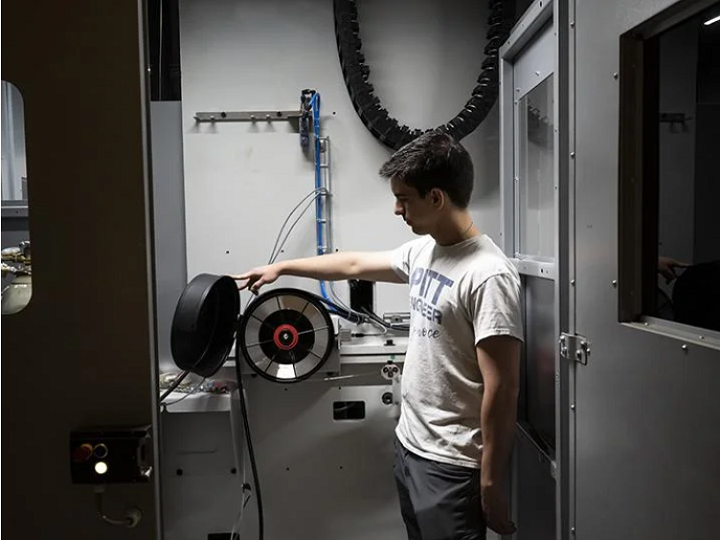 Jimenez displays the wire that the printer uses to construct objects. One advantage over other 3D printers is that the raw material is the same cheap and easy-to-find wire used by welders worldwide, rather than expensive and specialized powders.
Jimenez displays the wire that the printer uses to construct objects. One advantage over other 3D printers is that the raw material is the same cheap and easy-to-find wire used by welders worldwide, rather than expensive and specialized powders.Third-year PhD student Xavier Jimenez, who works in To’s lab, is using the Gefertec arc605 to create a process for 3D printing a new type of high-strength aluminum. The material could have potential in the aerospace industry, but it often cracks when it’s welded. This metal 3D printer uses advanced software and five-axis capabilities to rotate and tilt components during the printing process in order to create complex parts, and the hope is that Jimenez can figure out the best optimization for the printer to keep cracking to a minimum.
“You have to tune all these different parameters to figure out what will produce the best-quality weld. Every material behaves a little differently,” Jimenez explained.
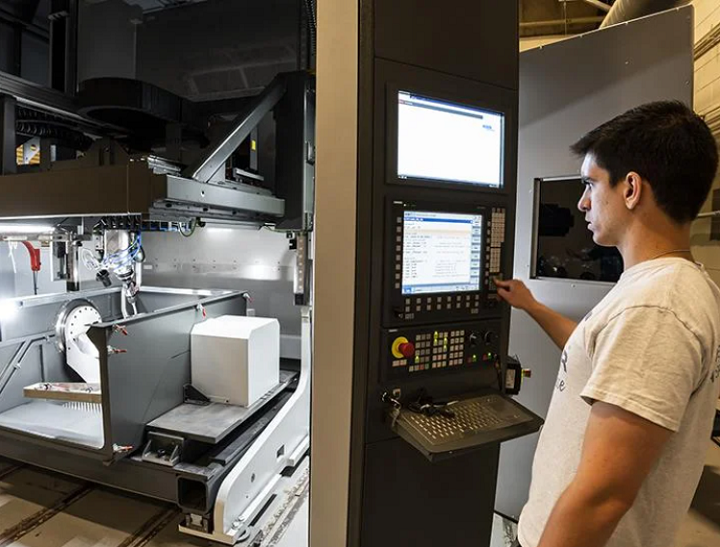 Jimenez operates the Gefertec printer using a computer terminal built into the machine.
Jimenez operates the Gefertec printer using a computer terminal built into the machine.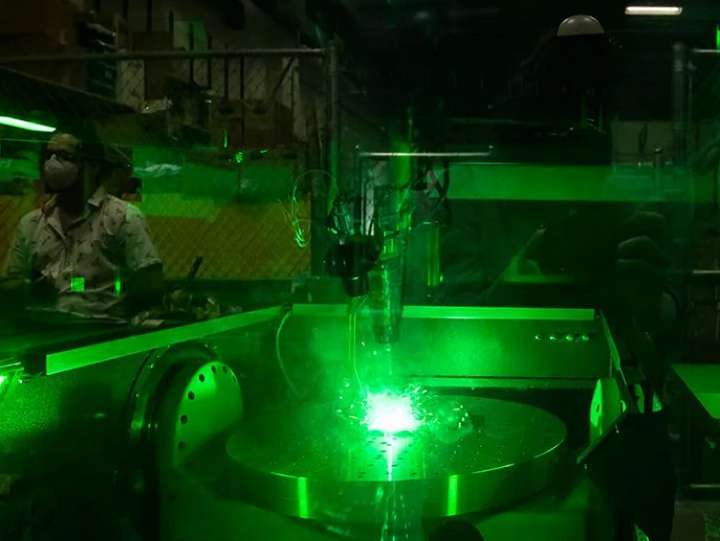 The Gefertec printer in action. Green glass protects viewers from the bright light of the device’s arc welder as it deposits layers of an aluminum alloy.
The Gefertec printer in action. Green glass protects viewers from the bright light of the device’s arc welder as it deposits layers of an aluminum alloy.Jimenez actually came to the university specifically to work with the Gefertec arc605, but like most everything else in the world in the last couple of years, COVID-19 got in the way of best laid plans. It took three years to finally get the printer onto campus, and once it finally arrived, it then had to be lowered piece by piece into the lab by a crane. Once fully assembled, the system is actually bigger than some studio apartments.
“It was a lot of work to get all the pieces together to get the machine working. We’re very happy that it’s here,” Jimenez said.
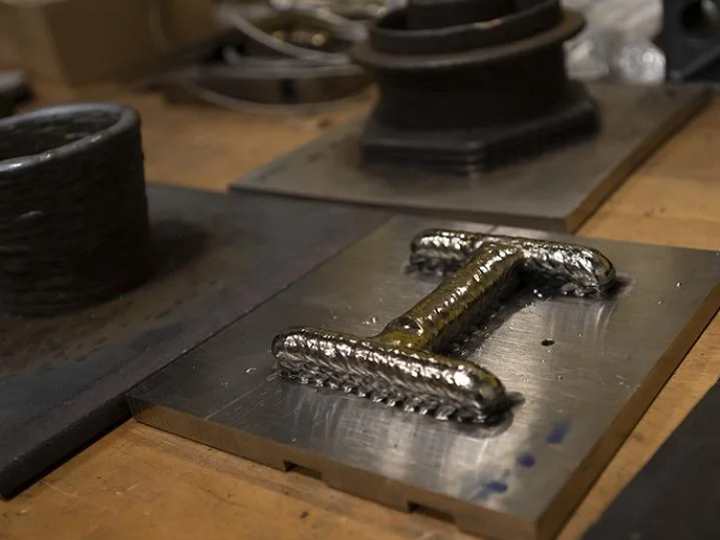 A test part of 3D printed titanium. When printing with titanium, researchers pump argon gas into the printer to ensure that the metal doesn’t chemically react with the air.
A test part of 3D printed titanium. When printing with titanium, researchers pump argon gas into the printer to ensure that the metal doesn’t chemically react with the air.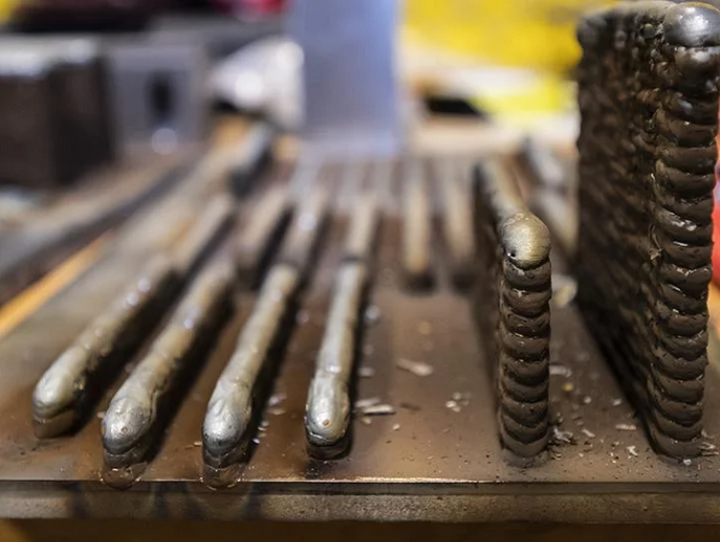 Simple “walls” of stainless steel welded onto a surface using the new printer.
Simple “walls” of stainless steel welded onto a surface using the new printer.Now that the Gefertec arc605 has been installed, the team in To’s lab is testing parameters for 3D printing different metals. The idea is to start modeling how the AM process affects a part, such as warping and changing the material’s microscopic structure, by testing the approach for a variety of materials, and then using X-rays and testing the material properties. Additionally, To is working with colleagues on a different project—embedding fiber optic cables into metal 3D printed parts to create smart components that can sense the deformation and temperature of the part.
Installing cutting-edge technologies, like Gefertec’s, in universities is extremely important for the development of the future workforce. If students learn to use additive manufacturing early, they will be valuable assets after graduation, as they can fit right in with companies that are already using AM, or help get it adopted at businesses that may still be unsure.
 One of the first objects made by Jimenez using the Gefertec arc605. The shape shows off the 3D printer’s ability to rotate the plate, laying down metals at different angles.
One of the first objects made by Jimenez using the Gefertec arc605. The shape shows off the 3D printer’s ability to rotate the plate, laying down metals at different angles.Subscribe to Our Email Newsletter
Stay up-to-date on all the latest news from the 3D printing industry and receive information and offers from third party vendors.
Print Services
Upload your 3D Models and get them printed quickly and efficiently.
You May Also Like
Heating Up: 3D Systems’ Scott Green Discusses 3D Printing’s Potential in the Data Center Industry
The relentless rise of NVIDIA, the steadily increasing pledges of major private and public investments in national infrastructure projects around the world, and the general cultural obsession with AI have...
3DPOD 260: John Hart on VulcanForms, MIT, Desktop Metal and More
John Hart is a Professor at MIT; he´s also the director of the Laboratory for Manufacturing and Productivity as well as the director of the Center for Advanced Production Technologies....
Etsy Design Rule Change Reduces Selection of 3D Printed Goods
Online marketplace Etsy has implemented a rule change requiring all 3D printed goods on the site to be original designs. The update to the site’s Creativity Standards states, ¨Items produced using...
E-Beam OEM Wayland Additive Partners with USC Racing to 3D Print Titanium Exhaust Collector
Every year, standards organization SAE International holds a competition called Formula SAE, in which students from both undergraduate and graduate programs design, build, and race small formula-style race cars. For...

































